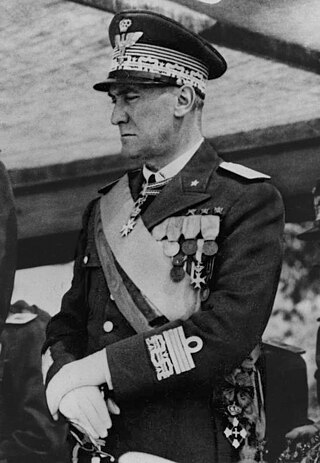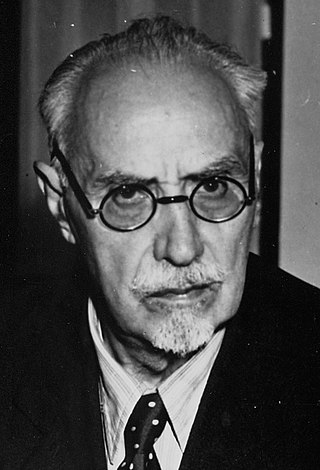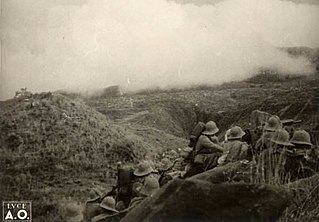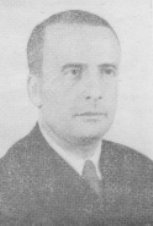
An institutional referendum was held in Italy on 2 June 1946, a key event of Italian contemporary history.

Rodolfo Graziani, 1st Marquis of Neghelli, was a prominent Italian military officer in the Kingdom of Italy's Regio Esercito, primarily noted for his campaigns in Africa before and during World War II. A dedicated fascist and prominent member of the National Fascist Party, he was a key figure in the Italian military during the reign of Victor Emmanuel III.

Pietro Badoglio, 1st Duke of Addis Abeba, 1st Marquess of Sabotino, was an Italian general during both World Wars and the first viceroy of Italian East Africa. With the fall of the Fascist regime in Italy, he became Prime Minister of Italy.

Ugo Cavallero was an Italian military commander before and during World War II. He was dismissed from his command due to his lacklustre performance, and was arrested upon the fall of Mussolini's regime. Cavallero was later freed by the Germans, but refused to collaborate and was found dead the following day.

Ivanoe Bonomi[iˈvaːnoe boˈnɔːmi] was an Italian politician and journalist who served as Prime Minister of Italy from 1921 to 1922 and again from 1944 to 1945.

During World War II, the Gran Sasso raid on 12 September 1943 was a successful operation by German paratroopers and Waffen-SS commandos to rescue the deposed Fascist dictator Benito Mussolini from custody in the Gran Sasso d'Italia massif. The airborne operation was personally ordered by Adolf Hitler, approved by General Kurt Student and planned and executed by Major Harald Mors.

The Armistice of Cassibile was an armistice that was signed on 3 September 1943 and made public on 8 September between the Kingdom of Italy and the Allies during World War II.

Vittorio Ambrosio was an Italian general who served in the Italo-Turkish War, World War I, and World War II. During the last phase of World War II Ambrosio supported the fall of Benito Mussolini and Italy's eventual renunciation of the German alliance.

The Second Battle of Tembien was a battle fought on the northern front of the Second Italo-Ethiopian War. This battle consisted of attacks by Italian forces under Marshal Pietro Badoglio on Ethiopian forces under Ras Kassa Haile Darge and Ras Seyoum Mangasha. This battle, which resulted in a decisive defeat of Ethiopian forces, was primarily fought in the area around the Tembien Province. The battle is notable for the large-scale use of mustard gas by the Italians.
The First Battle of Tembien was a battle fought on the northern front of what was known as the Second Italo-Ethiopian War. This battle consisted of attacks and counterattacks by Italian forces under Marshal Pietro Badoglio and Ethiopian forces under Ras Kassa Haile Darge. This battle was primarily fought around Worsege Pass in what was then the Tembien Province of Ethiopia.

The Battle of Amba Aradam was a battle fought on the northern front of what was known as the Second Italo-Abyssinian War. This battle consisted of attacks and counter-attacks by Italian forces under Marshal of Italy Pietro Badoglio and Ethiopian forces under Ras Mulugeta Yeggazu. This battle was primarily fought in the area around Amba Aradam which included most of Enderta Province.

The Battle of Shire was a battle fought on the northern front of what was known as the Second Italo-Abyssinian War. This battle consisted of attacks and counterattacks by Italian forces under Marshal of Italy Pietro Badoglio and Ethiopian forces under Ras Imru Haile Selassie. This battle was primarily fought in the Shire area of Ethiopia.

The March of the Iron Will was an Italian Fascist propaganda event staged from 26 April to 5 May 1936, during the final days of the Second Italo-Ethiopian War. Its goal was to capture the Ethiopian capital in a show of force. An Italian mechanized column under the command of Pietro Badoglio, Marshal of Italy, advanced from the town of Dessie to take Addis Ababa. The march covered a distance of approximately 200 miles (320 km).
The Badoglio Proclamation was a speech read on Ente Italiano per le Audizioni Radiofoniche (EIAR) at 19:42 on 8 September 1943 by Marshal Pietro Badoglio, Italian head of government, announcing that the Armistice of Cassibile between Italy and the Allies signed on the 3rd of September had come into force. It followed a speech on Radio Algiers by U.S. General Dwight D. Eisenhower at 18:30 also announcing the armistice.

The Franco-Italian Armistice, or Armistice of Villa Incisa, signed on 24 June 1940, in effect from 25 June, ended the brief Italian invasion of France during the Second World War.
The fall of the Fascist regime in Italy, also known in Italy as 25 Luglio, came as a result of parallel plots led respectively by Count Dino Grandi and King Victor Emmanuel III during the spring and summer of 1943, culminating with a successful vote of no confidence against the Prime Minister Benito Mussolini at the meeting of the Grand Council of Fascism on 24–25 July 1943. As a result, a new government was established, putting an end to the 21 years of Fascist rule in the Kingdom of Italy, and Mussolini was placed under arrest.

Raffaele Guariglia, Barone di Vituso was an Italian diplomat. He is best known for his brief service as Minister of Foreign Affairs in the short-lived 1943 World War II-era Italian government headed by Pietro Badoglio.

Angelo Raffaele Jervolino was an Italian Christian Democrat politician.

The Badoglio I government of Italy held office from 25 July 1943 until 24 April 1944, a total of 273 days, or 9 months and 3 days.

Renato Morelli was an Italian politician who served as Undersecretary to the Presidency of the Council of Ministers of the Kingdom of Italy in the Badoglio II Cabinet. He was later a member of the Italian Constituent Assembly.
















